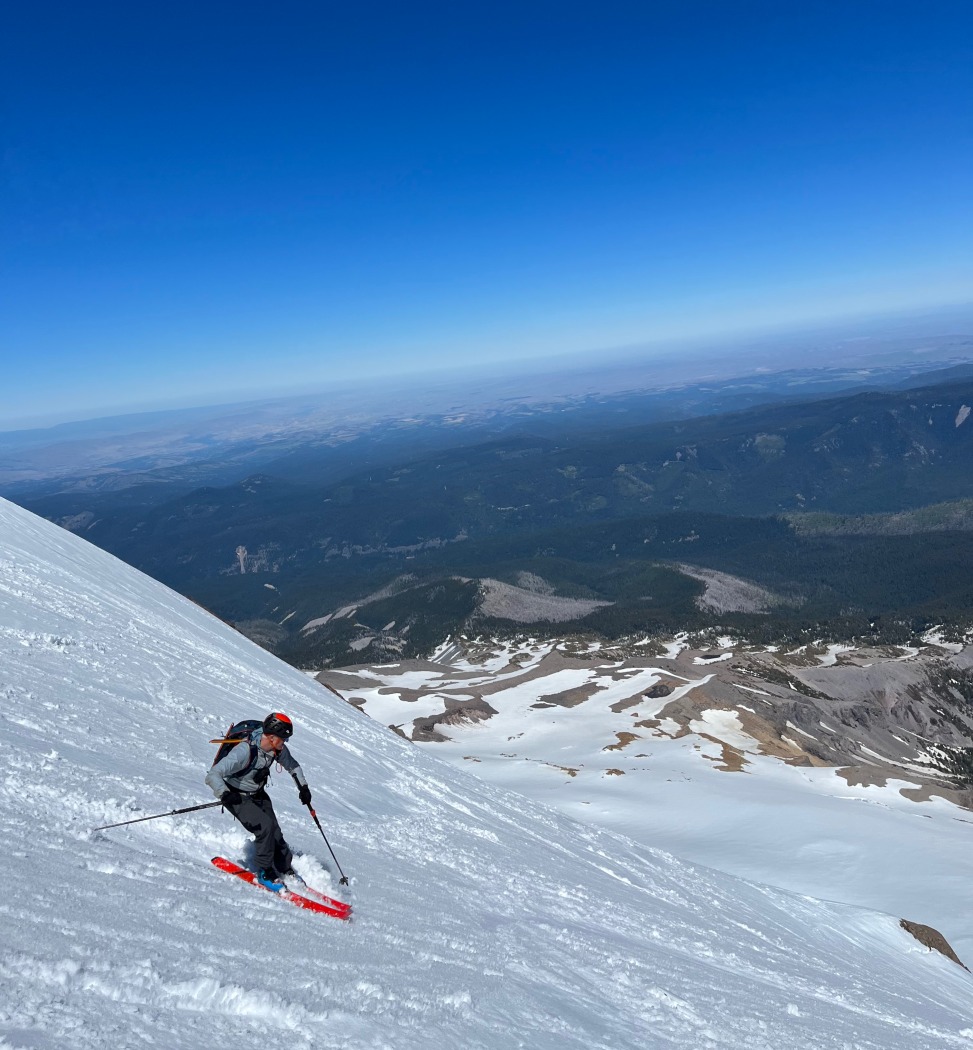
Mid-way through a fine Mt. Hood descent — this was a day when the Zero G was a highly desired plank.
The Blizzard Zero G 95 is a precise tool that flies on the uptracks and provides control and stability in steep, firm terrain. For a mission-driven ski, particularly spring missions, the Zero G 95 remains near the top of the class.
The saying goes like this: you are married to your ski boots and date your skis. I want to attribute this clever statement to someone; if that’s you, give me a shout. Although I imagine a cobbler in some mountain village dabbling in early iterations of ski boot prototyping; something to better control long and heavy skis, and thinking to herself that the marriage entails the boot-ski dance and the skier, rather than only the skier and the boot. The boot is critical, and so too is the ski.
I’m sitting and writing up my notes after skiing Blizzard’s Zero G 95 over the spring and early summer ski season here in the PNW. And I mention boots here because I think the boot pairing matters in the Zero G 95 and other skis like it. First, let’s run down the basic stats.
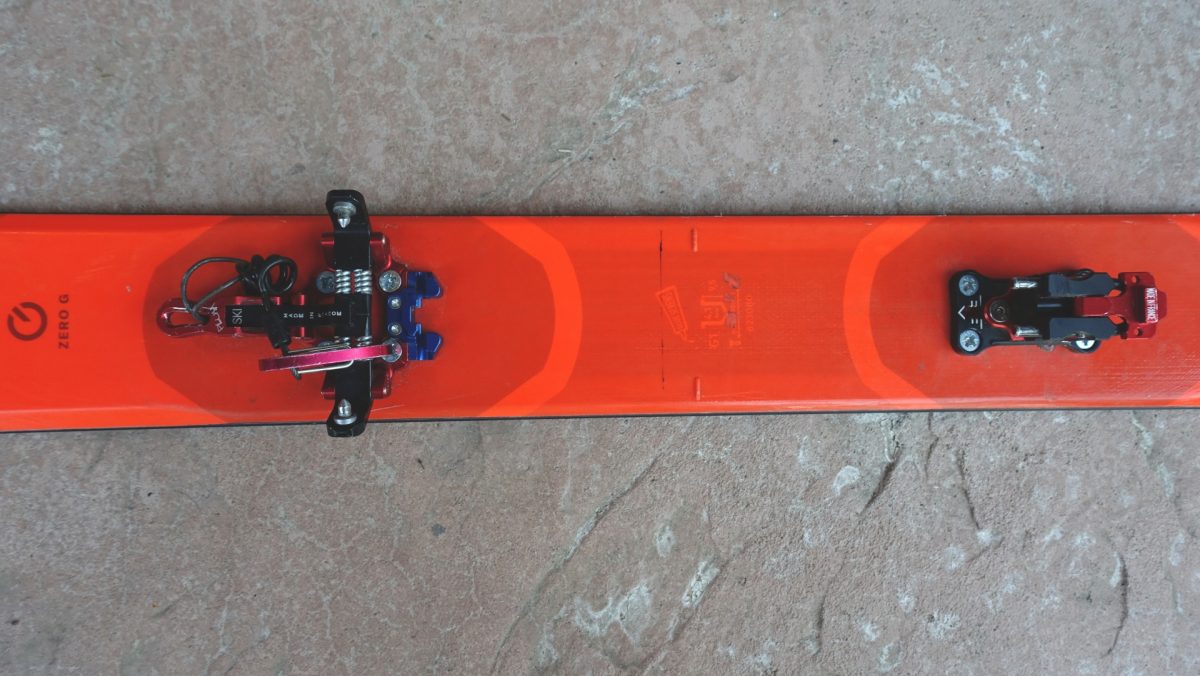
The binding mount area on the Blizzard Zero G 95 is reinforced with carbon where the binding toe and heel units are secured.
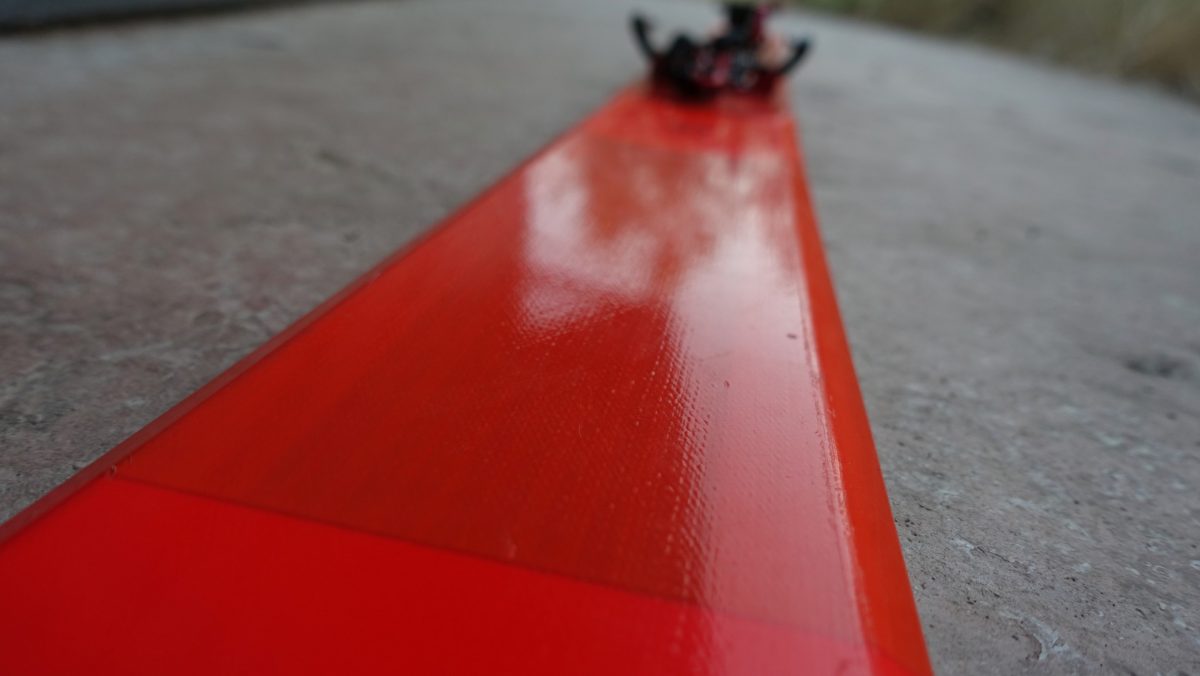
A wee bit of a window into the Paulownia core and underlying stringers on the Zero G 95.
Zero G 95 Stats
Weight: ~1164g/ski verified
Dimensions: [171cm] 126 / 94 / 110mm
Constriction: Woodcore (Paulownia and Poplar) with a carbon layer and partial sidewall.
Turn Radius: 22m (171cm)
Effective edge: ~70%
Tip Height: 5.5cm
Tip rocker length: ~27cm
Bindings: Plum R170 mounted +1.5cm
Boots used: Dynafit TLT X and Salomon S-Lab MTN Summit
Price: $749.95
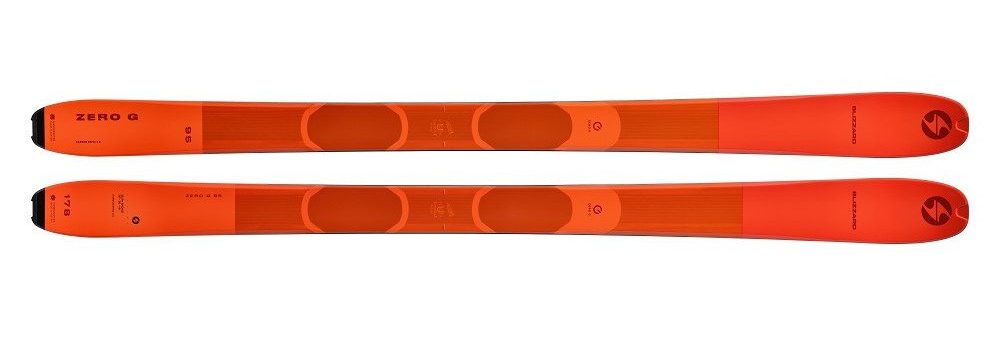
The 2022-2023 Blizzard Zero G 95: light, stiff, ready for firmness.
Here’s the link to the 2022/2023 Zero G 95 first look. In that post, I described what I was looking for in a ski of this ilk, a few notes about the engineering, the rocker-camber-rocker (flat tail) profile, its prowess on steep fall line and firm snow skiing, and a refined preciseness when jump turning and setting an edge. In many ways, the Zero G 95 is traditional, there are carbon stringers running lengthwise, a Paulownia core. The top layer of fiberglass has carbon woven in, and there are carbon reinforcements underfoot.
Many of the Zero G line of skis, including the 95, use the new Carbon Drive 3.0 build. It includes those two reinforced bi-directional carbon sections underfoot (located where the binding toe and heel units mount), and the unidirectional carbon layer running the ski’s length. According to Blizzard, this layer is lower in the ski relative to their Carbon Drive 2.0 construction. The intent was to make a more forgiving, less demanding ski. I wouldn’t place a timid beginner on this ski, but it’s not a bucking bronco, and it’s appropriate for intermediates on up. And in terms of results-oriented engineering outcomes, the ski is forgiving in suitable terrain, is blissful is wide open firm conditions, and when paired with the right binding, light as sunshine softening up high elevation slopes for a corn run.
Generally, for the Cliffnote reader, the ski is light on the uphills for a ski offering some semi mid-phat girth and is so fine for those chasing sun-kissed softening snow for thousands of feet in the spring. I’m not talking chunky, breakable, variable types of snow. I chose this ski for a period of the season when conditions are supremely predictable, meaning likely ice/firm, maybe chicken heads up high atop a volcano which transitions to creamy corn somewhere on the descent, or, at a minimum, smooth firm snow. When high pressure kicks in here, we can count on these conditions, and a ski like the Blizzard Zero G 95 reigns. Will the light tip get pushed around a bit if you are maching through an apron’s old deposit zone? Yes. To be expected, at least for me: this is a feathery light ski, with minimal material in the tip disallowing it to play a deep bass note through wet or refrozen mank. It likes high notes — notes that are tuned, though, not twangy or pingy or chattery like we get in some skis with abundant carbon.
Further, in the 171cm length that I tested, and prefer for spring skiing, there’s just not a ton of ski up front to get pushed around or lose control of. (This ski is ~10cm shorter than my mid-winter soft/variable snow ski.) When I see a funky snow surface in the distance, I dial back my turn radius and speed accordingly. For me, using boots like the Dynafit TLT X, which sport a very progressive yet soft flex, the skis were stable on boilerplate. It was a ski I’d actually prefer in those conditions when paired with this boot. The boot’s flex allows for an excellent interface to control the ski and sense when more or less pressure should be added to the tip or underfoot, for example. Running a too stiff boot with something tip-and-tail-stiff like the Zero G 95 may decrease sensitivity and leave some feeling like you’re head-banging to the ripest Scarlet-Fire you’ve ever heard when really you should be twirling. (With all due respect to the headbangers out there: headbang less, twirl more.)
The Two Ski Quiver and the Zero G 95
I do understand I am lucky. I love to backcountry ski, and I occasionally review skis. But, I’m constantly thinking about the two-ski quiver, which I believe is the number of skis to cover the vast majority of conditions we ski in. My preferred duo is a more rockered 105mm+ ski underfoot for soft snow and variable days and something shorter and stiffer, with minimal tip and tail splay for spring, steep, and firm conditions. I think pushing a wee bit over 1600g/ski for the wider ski is my max. For the spring ski, over the years, I’ve determined I want something bumping up to 90mm+ in width with a long effective edge for steeps and in the 1200g/ski weight class. I like the extra body underfoot compared to the 65mm and 80mm skis I’ve optioned. If you are optioning skis to infill the second half of a quiver, and it’s the firm snow spot you’re filling, consider this ski. But compared to some other slightly heavier skis, the DPS assortment comes to mind, you might find other options that perform great in a wider spectrum of snow conditions. I suppose that all depends on where you place your preference; I wanted to zero in on a ski excelling in firmer terrain and sporting a longer turn radius.
The Uphill
Mostly, I like going uphill. That’s a massive part of my brain’s organic algorithm determining what feels good and doesn’t when considering gear. In other words, skis are personal; we all have preferences about how we compromise on the down when we want something bordering on ethereal on the up. If you prefer light, the Blizzard Zero G 95 isn’t only in the conversation; it might be the thesis of the conversation. Say you are a morning uphiller at the local ski hill. With a 171cm Zero G 95 plus something like the Plum R170 binding, I’m pushing ~1370g of goods (ski + binding). I’m not talking to those aspiring to hone the skimo shuffle, I’m sure 1000g for the whole setup works, but I’m speaking to those who think 1370g is light, which it is.
More specifically, this ski serves those going deeper and longer in spring or if high pressure and no snow persists in winter (like last winter out West). If your approach is a mile or two to the top of your line, and that includes the vert, your organic algorithm might be set to prefer a heavier plank even if it is ~170cm. But putting in a long day of 10-15 miles and 5k-10k of up and down, I place a premium on lightness. The Blizzard Zero G 95 nails that for me. And with the long effective edge and general stiffness, they feel secure on steep traversing skin tracks.
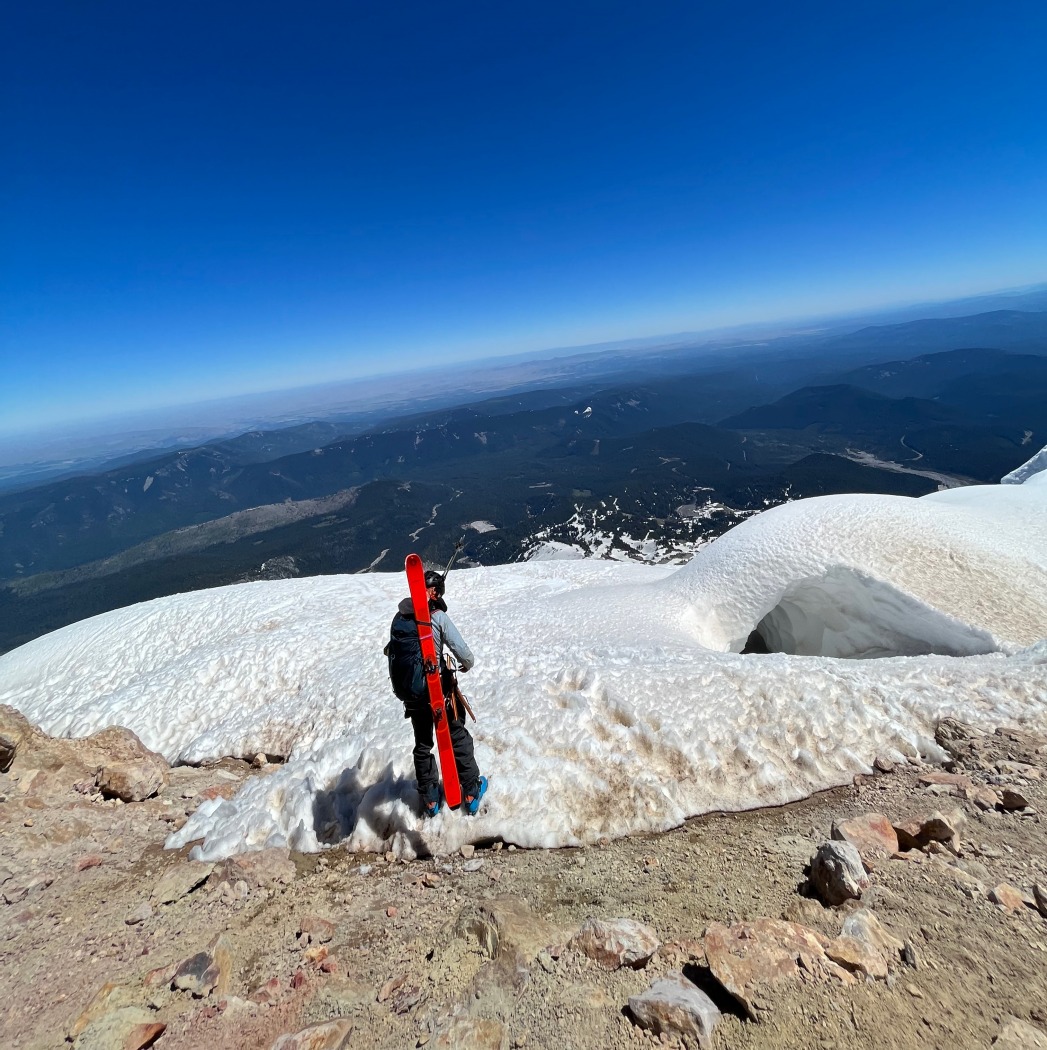
With the Zero G on your back and paired with an ~ 200g binding, there’s not a whole ton of downsides to carrying this setup.
More Field Testing
Powder
A short section here. Soft snow, soft light snow, and deep snow (read deep powder) is forgiving snow to a point. The Blizzard Zero G 95 is a ski that can handle duty as a semi-deep powder ski in lengths longer than 171cm, but you and the ski will ask for forgiveness. The outright stiffness of the front and tail, although there is some rocker in the tip, is not refined for outstanding flotation. Expect some tip-dive in soft light snow driving from a centered stance. I did take these boards out on two occasions in what I’d call dust on crust, even up to three inches of new, lower-density snow, and they performed great. But when we think of powder, that’s not really powder. I guess you’re not exploring this ski for deep powder anyway.
The Crud and Variable
If it’s deep crud and/or deep variable, the Blizzard Zero G 95’s front end will get pushed around and deflected. In these conditions, which I was not particularly seeking out with this ski, I decelerate and ski more conservatively. I also spent considerable time using the new Salomon S/Lab MTN Summit ski boot with the Zero G 95, a notably stiffer boot than the Dynafit TLT X. Even with the stout stiffness of the S/Lab MTN Summit, driving the ski through deepish crud felt more on the cruddy side of sensations than it would with a longer, wider, heftier, and by default, more damp ski. If an ~95mm wide ski is a must, but you are seeking a more damp and less deflectable ski in crud while giving up some weight savings, the G3 FINDr 94 is a solid choice; the ski alone, though, weighs ~1340g in 172cm.
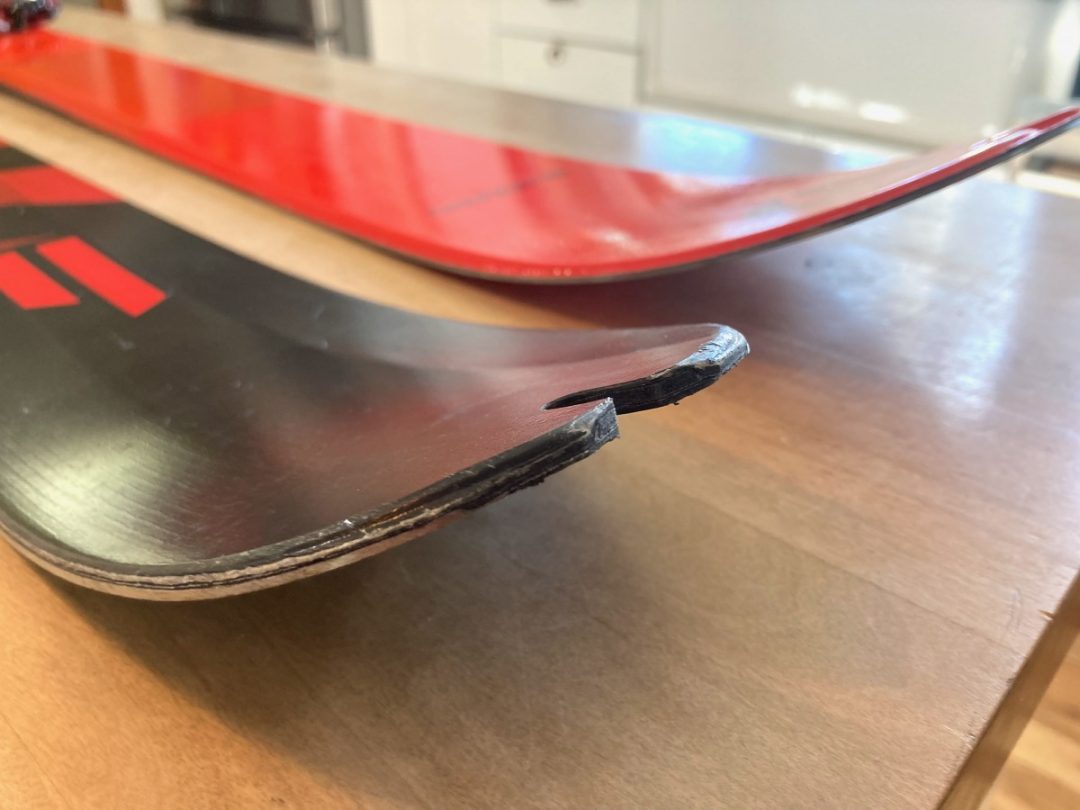
Side by side with a Hagan Ultra 82, another stiff ski lying around the house. The Zero G 95 has a bit more tip rise both in height and length. In shallow mank, it helps the ski float a bit and deflect less. But, in the deep mank, you’ll need to curb the speed and settle down.
That said, I noted some readers’ comments from the first look and sought out less deep, cruddy, and variable snow — still cruddy and variable, but only several inches of it — this was not a problem IMHO, with this ski. I could keep speed in a few inches of mashed-potato snow with no deflection, and the tip rise allowed for flotation over the not-so-deep chunkier portions of a volcano’s flank. Maintaining a centered and even slight forward, more aggressive stance also helped drive the ski in these conditions.
The ski’s width, at 95mm underfoot, helps too. This ski has more surface area than with a ~80mm underfoot plank. Across the board, I’d prefer the Blizzard Zero G 95 over my old and sold Salomon S/Lab X-Alps, Hagan Ultra 82s, and the Black Crows Mentis when holding good speed in less than ideal conditions. (We’ll publish a Mentis final look in a few weeks.)
Wind Affected Snow
Here I’m mainly writing about wind board. I like skiing stable wind board. And this is getting into the part of the review where the Zero G 95 shines a lovelight. The effective edge on the Zero G 95 is long due to the sidecut, lack of rocker, and general stiffness. When on edge, this ski is damn effective at holding that edge at hair-blown-back speeds, and even when shifting weight, initiating a turn, and railing a GS-style turn. You’ll want to do this again and again. The skis feel stable and will beg for big carving turns.
Firm Snow/Couloirs/Steep Panels
The qualifier comes out again, “for me.” For me, the build of the Zero G 95 and its flex and sidecut profile make it superb in these conditions: This is the ski I grabbed when seeking out the firmer and steeper conditions and the approach is long. Which, for that matter, includes most of the tours I seek in spring.
The ski’s tails are generally flat but releasable. The ski is strong, reliable, precise, and secure. Of note, I’m not straight lining; I like to make turns, and my frontal cortex (I think) is fully formed, so I’m trying to avoid and not huck cliffs. When jump-turning, with your weight centered, you should feel as if you’re on a solid foundation when landing the turn, setting the edge, taking a moment to exhale, and repeating. All this, too, should make you a more confident skier. And if the terrain and lack of consequences warrant, this is also where the Zero G 95 wants you to press the pedal, open it up a bit, and embrace the moment. The ski has a longish turn radius at 22m, but this will not stop you from transitioning from long turns to shorter turns to either check speed, avoid trees, or fly your slalom turn flag; the Zero G 95 feels fluid going from long to short to long.
I might as well include groomers here, as in firm groomers. For the on-piste uphillers looking to save some coin and also have a ski to go deep in the spring, the Zero G 95 will serve this double duty well. The skis will rail on the corduroy after you huff and puff and log the AM’s vert.
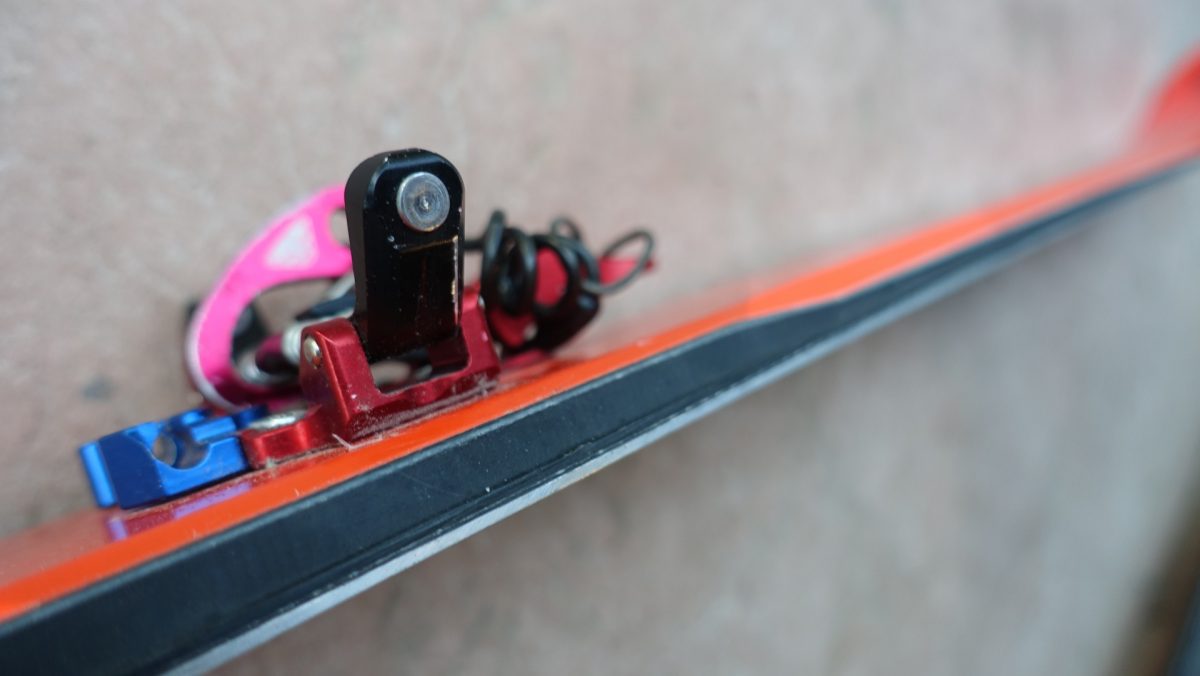
The Zero G 95 features a partial sidewall which helps with durability and adds a bit of dampness to this rather light ski.
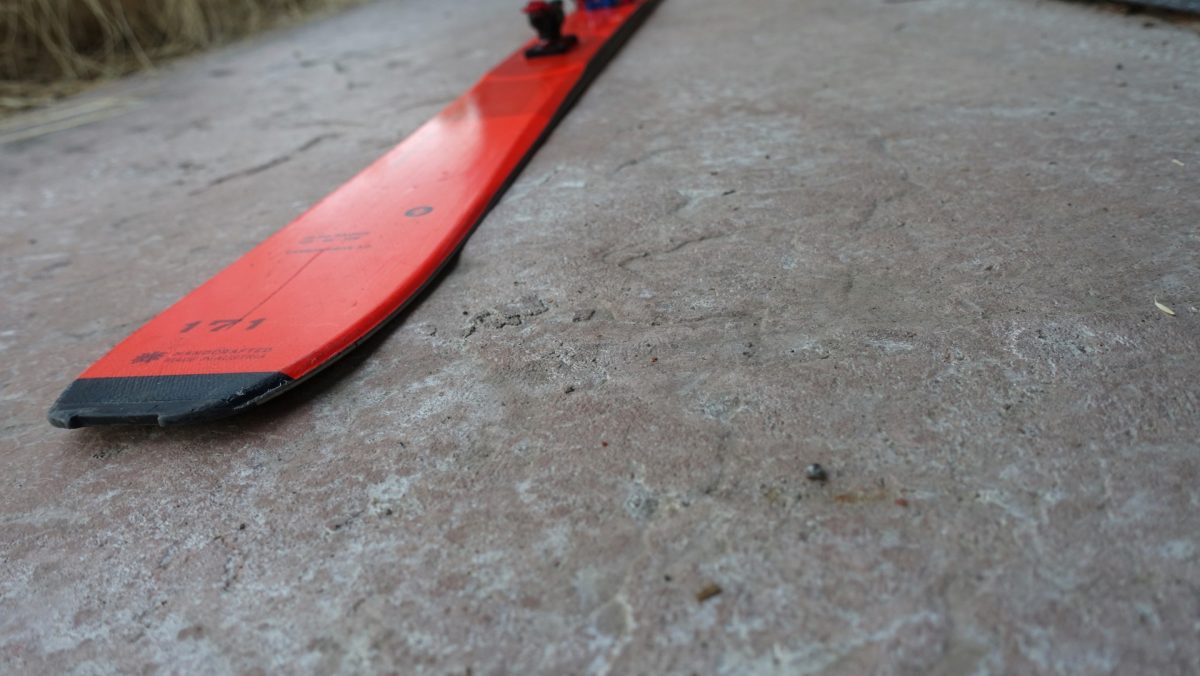
The Blizzard Zero G 95 and it flat tail. There’s minimal rocker, and a tapered tail for good release. This ski is easy to slot into snow vertically to build an anchor or secure a tent/shelter.
Final Thoughts
If the Zero G 95 is your only backcountry plank, be wise about where you bring this tool. I wouldn’t call the Zero G 95 all mountain, and certainly not uber “modern” or heavy enough for those checking the freeride box. As a light ski (this is a ski decidedly in the light ski territory, not something masquerading as a tourer), it feels at home on the skin tracks.
With that lightness, and the carbon construction, come the requisite limitations, which I’m hoping I noted in the field testing section. I find skis with an extra dose of carbon and Paulownia to be somewhat twitchy in less than ideal conditions, especially if the ski falls under the 1200g mark, which the Zero G 95 in a 171cm does. But those more finicky skis, in my experience, are skinnier underfoot. The extra 1.5 cm underfoot of the Zero G 95, compared to, say, an 80mm underfoot ski, alleviates some of the negative characteristics we often associate with lighter skis.
WildSnow, historically, places a premium on efficiencies throughout your tour. If the maxim of 90% of it all is uphill and 10% downhill holds true, think wisely about the bindings you pair with the Zero G 95. I’ve read of folks with Kingpins on this board and other bindings going way beyond the 300g threshold. We’re all for you being you, as long as you’re not harming others, but moving into a light binding on this ski, even a race binding (or something with race DNA like the PLUM R170), might make sense. Give some thought to what exactly you plan to do on this ski; likely, you’ll not be hucking. Let lightness rule. The Zero G 95 is the ski to experiment with how light you’re willing to go with a binding.
Back to the quiver — and a limited quiver at that — two pairs of skis. You’ll want a powder/soft snow ski if you live in a part of the world where those conditions are an option, and the Zero G 95 is on your radar. When conditions are predictable, like in spring, and you’ve got an adventurous spirit, big lungs, or at least a well-conditioned aerobic system, I wouldn’t hesitate to throw down for a pair of the Blizzards. Like that drink from Austria, they’ll give you wings.
Regarding marrying the boots and dating the skis — I’m not up to snuff on the dating app scene and what commitment may or may not look like when swiping left and right. I do know this: the 2022/2023 Zero G 95 is worth multiple dates and even long-term commitment, and yes, for those looking for a through-thick-and-thin sort of deal, nuptials.
Shop for the 2022/2023 Zero G 95.
Jason Albert comes to WildSnow from Bend, Oregon. After growing up on the East Coast, he migrated from Montana to Colorado and settled in Oregon. Simple pleasures are quiet and long days touring. His gray hair might stem from his first Grand Traverse in 2000 when rented leather boots and 210cm skis were not the speed weapons he had hoped for. Jason survived the transition from free-heel kool-aid drinker to faster and lighter (think AT), and safer, are better.
